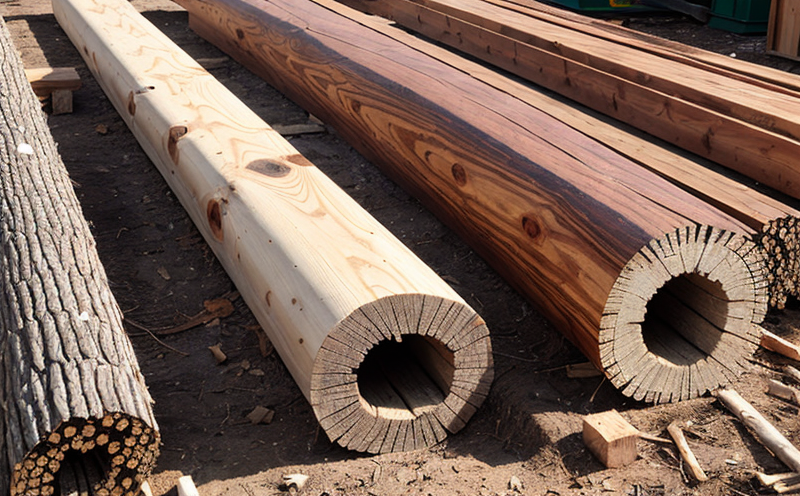Long-Term Field Performance Testing of Treated Wood
In the realm of agriculture and forestry testing, ensuring the durability and longevity of treated wood is crucial. This service focuses on long-term field performance testing of treated wood, which involves assessing its resistance to environmental stresses such as moisture, temperature fluctuations, and biological attacks over extended periods in real-world conditions.
The need for this type of testing arises from the critical role that treated wood plays in various applications like building structures, fence posts, and utility poles. The service entails exposing specially prepared wood specimens to natural environmental elements under controlled conditions to simulate long-term exposure. This approach ensures that the results are reliable and can predict the actual performance of the wood in its intended application.
The testing process typically involves selecting appropriate specimen sizes and types based on the intended use, such as posts or beams. These specimens are then treated with preservatives according to specified protocols and allowed to weather naturally over an extended period. The duration can vary from months to years, depending on the specific requirements and standards being followed.
The testing process is designed to mimic real-world conditions as closely as possible. This includes exposing the specimens to various environmental factors such as temperature changes, humidity levels, and exposure to UV radiation. Additionally, biological agents like fungi and insects are allowed to interact with the treated wood under controlled conditions that replicate their natural habitat.
The data collected during this testing period is meticulously recorded and analyzed. Parameters measured include resistance to decay, physical properties such as strength and durability, and visual assessments of any signs of deterioration. This comprehensive approach ensures that all aspects affecting the performance of treated wood are accounted for.
By offering long-term field performance testing, we provide our clients with a valuable tool for ensuring that their products meet stringent quality standards and regulatory requirements. This service is particularly beneficial for companies involved in agricultural structures, forestry applications, and other sectors where treated wood plays a crucial role. The insights gained from this testing can lead to improved product designs and enhanced sustainability practices.
Furthermore, long-term field performance testing helps manufacturers comply with international standards such as ISO 6389 for preservative treatments in wood and EN 350-2 for treated wood products. These standards provide a framework for ensuring that the tested specimens accurately reflect real-world conditions, thereby enhancing trust and reliability within the industry.
The results of this testing are invaluable for R&D engineers who can use them to refine their formulations and processes. Compliance officers benefit from these tests as they ensure adherence to regulatory requirements, while quality managers gain critical data to improve product performance and consistency. Procurement teams also find this service useful in selecting reliable suppliers and materials.
Applied Standards
The long-term field performance testing of treated wood is guided by several international standards that ensure the reliability and accuracy of the results. These include:
- ISO 6389: Preservative treatments in wood
- EN 350-2: Treated wood products – Part 2: Requirements for treated wood used in construction
- ASTM D1414: Standard practice for field testing of preservative-treated wood by exposure under controlled conditions and subsequent immersion tests
These standards provide a comprehensive framework that ensures the specimens are tested under consistent and replicable conditions. Compliance with these standards not only enhances the credibility of the test results but also facilitates international trade by ensuring compatibility with global regulatory frameworks.
Scope and Methodology
The scope of long-term field performance testing includes exposing treated wood specimens to a range of environmental conditions that simulate real-world scenarios. This involves placing the specimens in outdoor environments where they are subjected to natural elements such as sunlight, rain, temperature fluctuations, and humidity levels.
Once the specimens have been prepared and treated according to specified protocols, they are carefully positioned in areas known for their specific climatic conditions. This ensures that the specimens experience a variety of environmental stressors that can affect wood durability and preservation over time.
The methodology also involves regular monitoring and recording of various parameters throughout the testing period. These include physical properties such as weight loss, dimensional changes, and mechanical strength tests. Visual inspections are conducted to identify any signs of deterioration or decay due to biological agents.
Data collected from these observations is analyzed using statistical methods to determine trends and patterns in the performance of the treated wood specimens. This analysis helps in understanding how different factors influence the durability and longevity of the wood, providing valuable insights for continuous improvement in product formulations and processes.
Benefits
- Informed Decision-Making: Provides accurate data to guide decision-making on material selection and process improvements.
- Compliance Assurance: Ensures that products meet international standards and regulatory requirements.
- Enhanced Product Quality: Identifies potential weaknesses in product design and manufacturing processes.
- Sustainability: Aids in the development of more sustainable and long-lasting wood-based products.





